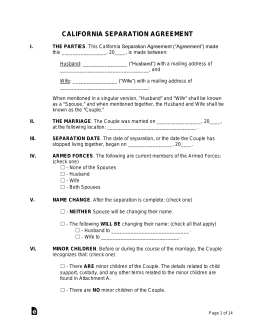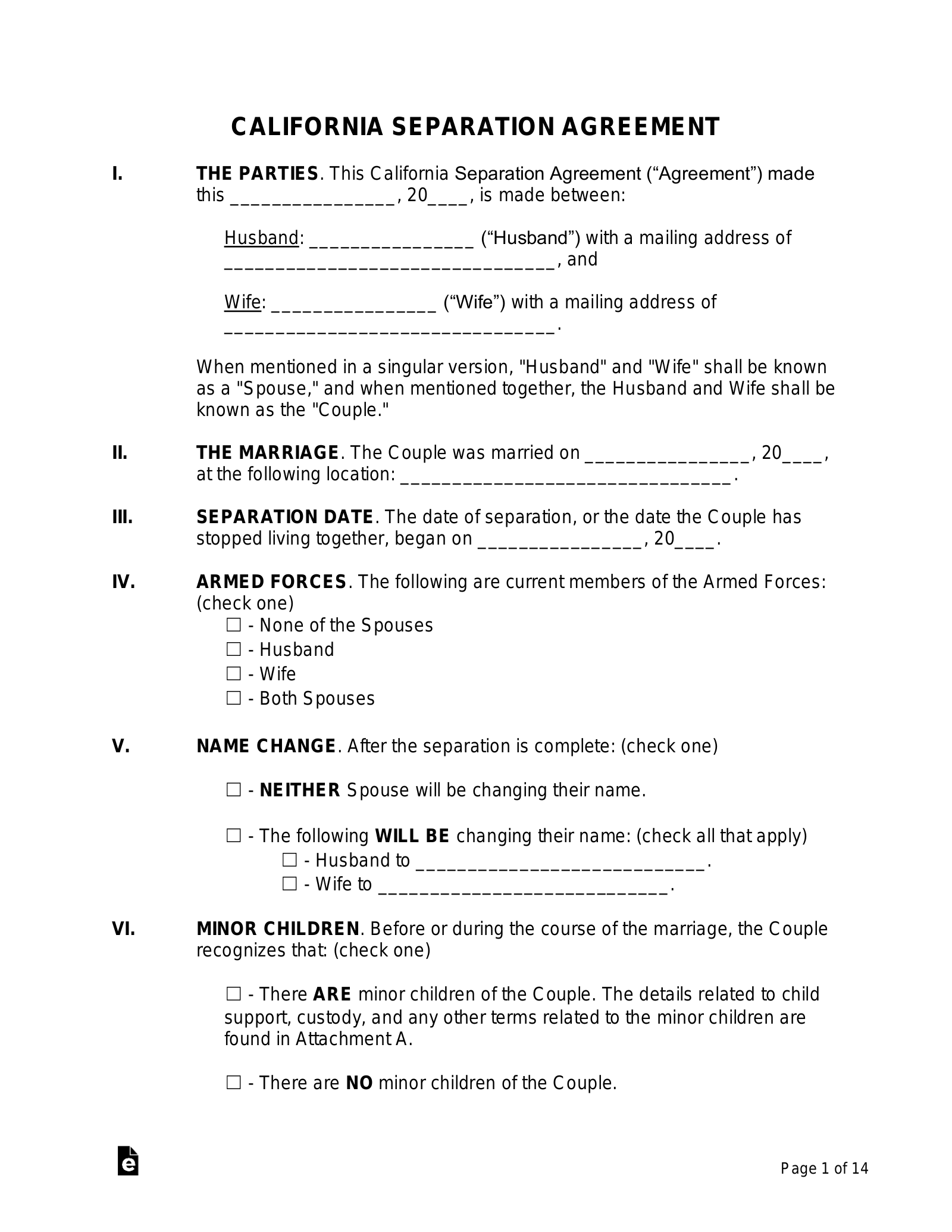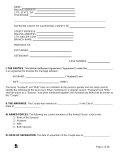Updated January 30, 2024
A California separation agreement is a legal instrument married couples use to divide their assets and no longer live together while remaining married. It becomes legally binding after being notarized by both spouses and is used by the court during the separation process.
Is a Separation Agreement legal in California?
Yes, a legal separation is lawful in the state of California if it is based on the following grounds:
- Irreconcilable differences, which have caused the irremediable breakdown of the marriage; or
- Permanent legal incapacity to make decisions.[1]
What Does It Cover?
Much like a divorce, legal separation in California covers:
- Division of assets and debts;
- Alimony;
- Child support payments; and
- Child custody arrangements.[2]
Residency Requirements
One of the spouses must have lived and been a resident of California for at least 6 months and residing in the county where the separation is being filed for 3 months.[3]
How to File a Legal Separation (5 steps)
- File with the Court
- Serving the Other Spouse
- Financial Disclosure
- Write a Separation Agreement
- Finalizing
1. File with the Court
Complete and make 2 copies of:
- Form FL-100 (Petition)
- Form FL-110 (Summons)
- If there are children under 18 years old of the relationship – Form FL-105 (Declaration Under Child Custody Jurisdiction and Enforcement Act (UCCJEA))
Attach a $435 filing fee. If the petitioning spouse cannot afford the filing fee, complete Form FW-001 (Request to Waive Court Fees).
File the original with 2 copies and pay the filing fee at a Superior Court Location.
2. Serving the Other Spouse
The petitioner cannot serve the defendant. An adult must be selected and hired to act as the server that can be:
- A family member or friend not involved in the case;
- A professional process server (Use ABClegal.com, CaliforniaServe.com, or ProcessServerOne.com)
- A local Sheriff (Find an Office)
A copy of the forms filed with the court must also be served to the other spouse. In addition, Form FL-120 (Response) must be included to give the spouse 30 days to respond to the court.
Afterward, the server will complete Form FL-115 (Proof of Service of Summons), make a copy, and file both with the court.
3. Financial Disclosure
Within 60 days of filing the initial filing, the petitioner must disclose their financials with their spouse. This can be done by completing the following forms:
- Form FL-140 (Declaration of Disclosure)
- Form FL-150 (Income and Expense Declaration)
- Form FL-142 (Schedule of Assets and Debts)
- Forms FL-160 (Property Declaration)
- Tax Returns (for the last 2 years)
If the other spouse is filing a response to the court (recommended), they must complete the above financial disclosures and serve the petitioning spouse.
If both spouses disclose their financials, both must complete Form FL-141 (Declaration Regarding Service) and file with the court to prove the other spouse has received the disclosures.
What if both spouses don’t want to disclose their financials? Then both spouses must complete Form FL-144 (Stipulation and Waiver of Final Declaration of Disclosure).
4. Write a Separation Agreement
At this step, the court recommends the spouses agree to write a separation agreement. It is required that both parties sign and notarize the agreement.
What if both spouses cannot agree? A judge will have to decide the case. Either spouse can file Form FL-300 (Request for Order) to request a court date.
5. Finalizing (if a separation agreement is made)
If a response was filed by the defendant, either spouse must file the following:
- Already completed Form FL-115 (Proof of Service of Summons)
- Petitioner’s and defendant’s Form FL-141 (Declaration Regarding Service) (both the preliminary and final versions) – If financial disclosures were not made, then both spouse’s Form FL-144 (Stipulation and Waiver of Final Declaration of Disclosure)
- Form FL-130 (Appearance, Stipulations, and Waivers)
- Form FL-170 (Declaration for Default or Uncontested Dissolution or Legal Separation)
- Form FL-180 (Judgment)
- Form FL-190 (Notice of Entry of Judgment)
- Separation Agreement (notarized version)
- 2 pre-stamped envelopes (sufficient size) for the court to return. 1 envelope must be addressed to the petitioner and 1 to the defendant.
- If minor children of the couple are involved, attach the following:
- Already completed Form FL-105 (Declaration Under Child Custody Jurisdiction and Enforcement Act (UCCJEA))
- Already completed Form FL-150 (Income and Expense Declaration)
- Form FL-192 (Notice of Rights and Responsibilities and Information Sheet on Changing a Child Support Order)
- Form FL-350 (Stipulation to Establish or Modify Child Support and Order) – Attach to Form FL-180 (Judgment)
- Form FL-342 (Child Support Information and Order Attachment) – Attach to Form FL-180 (Judgment)
- Form FL-195/OMB No. 0970-0154 (Income Withholding for Support)
- Form FL-341 (Child Custody and Visitation Order Attachment) – Attach to Form FL-180 (Judgment)
If a response was not filed by the defendant, then Form FL-165 (Request to Enter Default Judgment) must be attached with a pre-stamped envelope addressed to the defendant and the return area (upper-left) to mention the court clerk’s address.
Related Forms
Download: PDF, MS Word, OpenDocument
Download: PDF, MS Word, OpenDocument




